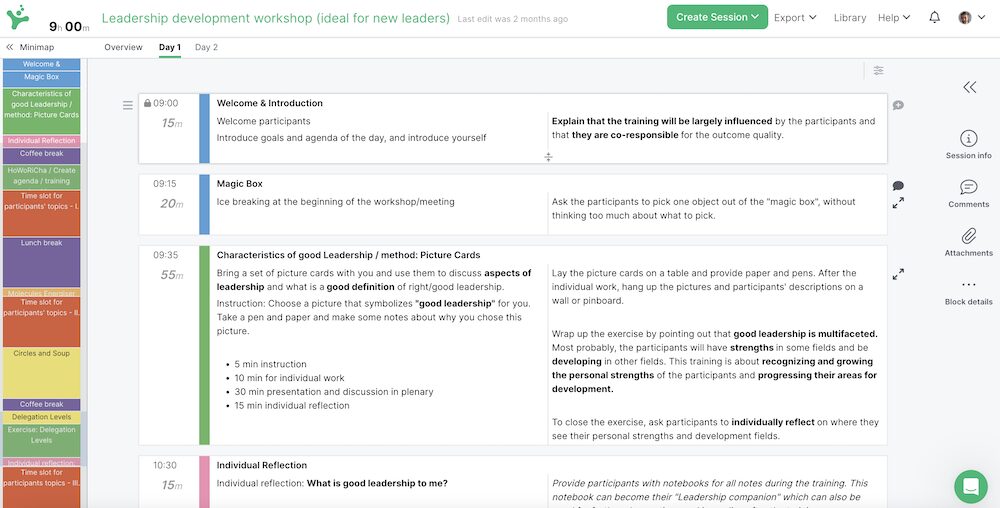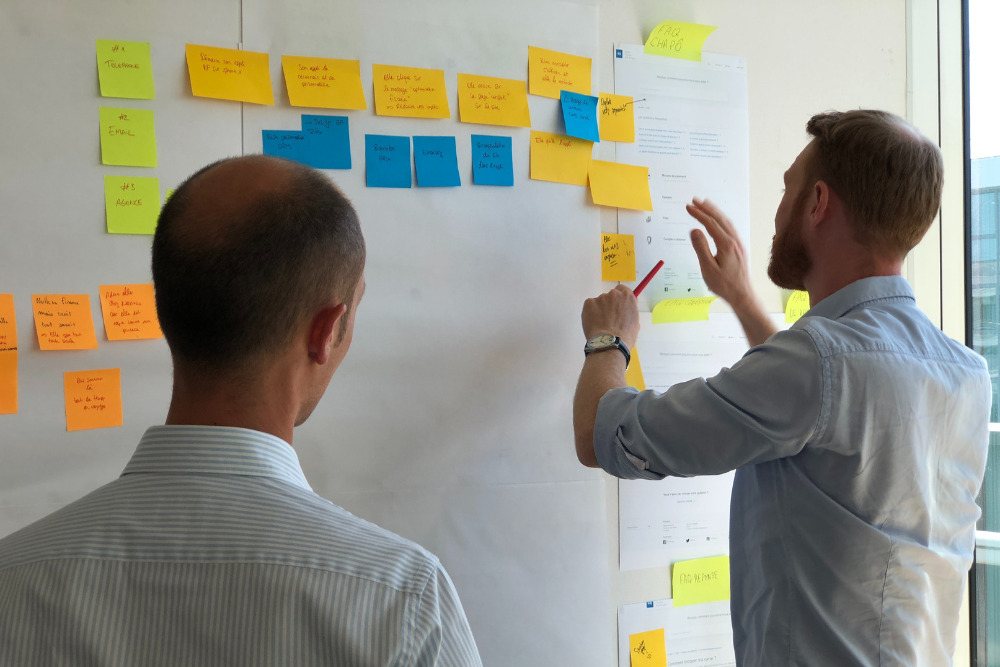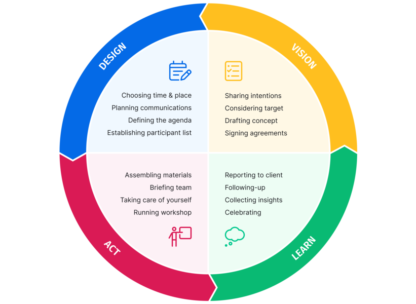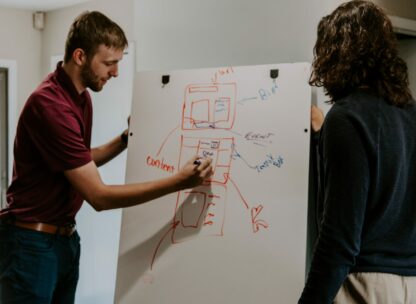39 best leadership activities and games

Good leaders can make or break a team. While more and more people are being asked to step into leadership roles, the path to becoming a good leader is long and not always straightforward. This is where leadership activities come in.
Leadership activities are a great way of developing the skills and competencies needed to be an effective leader. It's not easy to learn these skills, especially when so many leaders don't receive effective training or support. In this article, we'll explore the leadership activities you should master in order to lead a high-performing team and become a better leader!
Learning the why and how of being a great leader alongside practical techniques and frameworks is one of the easiest ways to become a better leader.
Anyone in a leadership role has both a big influence and responsibility for their team. Some of the aspects they need to pay attention to in order to be a good leader are:
- Setting the climate of a workplace
- Making decisions
- Inspiring team members
- Setting values for their team
- Improving team spirit and cohesion
- Being responsible for their team’s communication and wellbeing
- Developing leadership skills in other team members
There are a number of tools to help you with leadership development. Coaching, peer support circles, and leadership development workshops can all help one to become a better leader.
Leadership activities such as those featured here are also effective at introducing leadership concepts and learning how to solve common leadership challenges. You might run these leadership training activities during a workshop, add them to an ongoing learning program or simply introduce them to managers as needed.
In this guide, we’ve grouped leadership activities by these core competencies, so you can choose the right activity to help yourself or others develop their leadership skills. Let’s dive in!
What are leadership activities?
Leadership activities are exercises designed to help develop leadership skills and enable leaders to be more effective in their roles. They can include activities that help train new leaders and improve core leadership skills like problem-solving, active listening, or effective group management.
You’ll also find that the best leadership development activities give leaders tools and techniques they can use on the job. It’s one thing to know that leaders need to be good listeners, but quite another to be given a framework and toolkit that means you are a great listener who always helps their team feel heard and understood.
The exercises below are not only great to use when training leaders, but they are practical techniques leaders can use with every team member immediately, whatever their leadership style.

What are leadership activities used for?
While managers might approach tasks differently based on their leadership style, there are skills and competencies that all leaders should learn in order to best service their team. Learning how to be a good leader can be difficult, so using exercises and activities to improve leadership skills in a safe, experiential environment can help leaders be more effective in their role.
If you’re running a leadership development program, you might use these activities during the training program. For example, after conducting a self-assessment and deciding how they want to develop as a leader, participants might work on improving their leadership skills with these activities.
Whether you’re running such a program and developing managers internally with workshops or simply want to brush up on your own leadership skills, these exercises are a great place to begin.
A bespoke leadership development workshop (like the one featured in this leadership template!) is also a natural place to include these activities.
In SessionLab, it’s quick and easy to design a leadership workshop fit for your needs. Start by dragging and dropping blocks to design your outline. Add minute-perfect timing and instructions to each activity to refine your agenda.
When you’re ready to share with collaborators or participants, export your workshop agenda in PDF, Word, Powerpoint or invite them directly to the session.

Leadership training activities for building a positive work climate
Leaders are role models to their colleagues and organization. Their leadership styles, principles, and values determine the culture that drives their organization’s behavior.
That is why a competitive, paranoid leader can easily create an organization where team members are similarly competitive and less open to collaboration. While a leader who is open and inclusive will create a climate of openness and inclusiveness. How they behave, and what they consider the norm, also affects which kinds of behaviors are enforced and celebrated and which behaviors are punished.
The following leadership activities can help you in recognising important leadership behaviors that result in a productive workplace. They can also be used by leaders to set the stage for team bonding and a great workplace environment with their team. A must for all leaders!
| Leadership activity | Length in minutes | Participants | Difficulty |
|---|---|---|---|
| Leadership Envelopes | 30 – 90 | 6 – 30 | Low |
| Your Favourite Manager | 20 – 45 | 6 – 50 | Medium |
| Leadership Pizza | 30 + | 2 – 20 | Low |
| Playing with Status | 15 – 30 | 6 – 30 | Low |
| Heard Seen Respected | 35 – 45 | 4 + | Low |
Leadership Envelopes
Leadership games like this help groups translate abstract leadership principles into practical on-the-job behaviors. Participants work in groups to come up with real-life applications of different leadership principles.
The groups conduct multiple rounds of discussion to build upon each others’ ideas, and in the end, evaluate the best ideas to identify the most useful behaviors. This is also a great activity to run with all your team members. Seeing how they consider and respond to different leadership styles can help you focus on the right approach as a leader!
Leadership Envelopes #leadership #issue analysis #thiagi
Leadership exercise in groups, working with practical leadership principles.
This activity helps groups to translate abstract leadership principles into practical on-the-job behaviours. Participants work in groups to come up with real-life application of leadership principles. The groups take multiple rounds to build upon the ideas of each other, and in the end, evaluate the best ideas to identify the most useful behaviours.
Your Favourite Manager
In this activity, participants take on three different employee personas and list the behaviors of a positive leader or manager and a negative one from the perspectives of those employees. After some individual reflection, participants compare their lists, first in pairs and then in groups. Finally, they collect the ultimate do’s and don’ts for managers and leaders.
Any activity that encourages deep reflection on your own leadership style and those of your role models is a wonderful way to grow. I’ve been especially inspired by how some of my old bosses approach problem solving while I was a team member working beneath them.
My Favourite Manager #management #leadership #thiagi #teamwork #remote-friendly
Participants work individually, assuming the roles of three different people and brainstorming their perceptions of three most favourite managers and three least favourite managers. Later, they work with a partner (and still later, in teams) to prepare a list of dos and don’t-s for improving employees’ perception of a manager’s style.
Leadership Pizza
This leadership development activity offers a self-assessment framework for people to first identify the skills, attributes and attitudes they find important for effective leadership, and then assess their own development in these areas. This framework is also a great tool to set individual leadership development goals in a coaching process.
We love activities that allow team members to reflect on different leadership styles and assess their own skills and preferences. The visual format makes it easy to share and reflect on leadership styles later too!
Leadership Pizza #leadership #team #remote-friendly
This leadership development activity offers a self-assessment framework for people to first identify what skills, attributes and attitudes they find important for effective leadership, and then assess their own development and initiate goal setting.
Playing with Status
The best leadership training activities often allow managers to work on their leadership skills while also providing an opportunity to reflect on their leadership style and how it might affect other employees.
Playing with Status is a role playing game where pairs enact a job interview or coaching session and enact different versions of the conversation based on whether each person has high or low status. By experiencing the effect of status on the relationship, would-be leaders can consider how they interact with other members of their team and create a more positive workplace culture.
Heard Seen Respected
Standing in the shoes of others, practicing empathy and ensuring that everyone on a team is able to be heard is a necessity for great leaders and your team in general. In this activity, participants shift between telling stories where they were not heard, seen or respected and then being listeners who do not pass judgment.
Remember that leadership training should often start with the fundamentals of respect and empathy. If you can’t respect and empathize with your team members, how can you expect them to do the same for you? Keeping things simple with an activity like Heard Seen Respected can be an especially effective option whether you’re working online or offline.

Team building leadership activities
Every leader has an integral role in the formation of the teams they work with. Whether you are consciously working on it or not, your attitude and actions as a leader will significantly influence team cohesion, communication and the team spirit of the people you work with.
This comes through in small everyday actions, the way you share responsibilities, the way you empower colleagues, and the way you foster a cooperative work environment as opposed to a competitive one.
Sometimes, it can also be effective to run team building activities with your company that are expressly focused on helping teams come together and bond. Try using the following leadership team building activities with new teams, or groups that need to spend a little time getting to know each other better.
| Leadership activity | Length in minutes | Participants | Difficulty |
|---|---|---|---|
| Marshmallow challenge | 45 – 60 | 6 – 100 | Medium |
| Blind Square Rope Game | 40 – 45 | 4 – 20 | Low |
| Tower of Power | 20 – 60 | 6 – 24 | Medium |
| Minefield | 15 – 30 | 4 + | Low |
| Crocodile River | 60 – 120 | 10 – 40 | Medium |
| Human knot | 15 – 30 | 7 – 20 | Low |
| Who are you? The pirate ship exercise | 10 + | 4 + | Low |
Marshmallow challenge
The Marshmallow Challenge is a team-building activity in which teams compete to build the tallest free-standing structure out of spaghetti sticks, tape, string, and the marshmallow that needs to be on the top. This leadership activity emphasizes group communication, leadership dynamics, collaboration, and innovation and problem-solving.
It’s a wonderful game that allows participants’s natural leadership qualities to shine through, and it helps teams have a lot of fun too!
Marshmallow challenge with debriefing #teamwork #team #leadership #collaboration
In eighteen minutes, teams must build the tallest free-standing structure out of 20 sticks of spaghetti, one yard of tape, one yard of string, and one marshmallow. The marshmallow needs to be on top.
The Marshmallow Challenge was developed by Tom Wujec, who has done the activity with hundreds of groups around the world. Visit the Marshmallow Challenge website for more information. This version has an extra debriefing question added with sample questions focusing on roles within the team.
Blind Square Rope Game
This activity is a tried and tested game that asks teams to communicate well and solve a problem as a team. Not only is this a fun team building activity, but it’s a great way for potential leaders to step up and help their team win!
Start by tying a length of rope into a circle and then instruct participants they will have 20 minutes to turn it into a square, with fifteen minutes to plan their actions and five minutes to implement. Here’s the catch – no one may touch the rope until you begin, and every team member is blindfolded during implementation. This is an effective leadership game that is great with both small groups and larger teams separated into breakouts.
Tower of Power
All leaders need to work closely with other members of their organization in order to succeed. This leadership game encourages groups to work together in order to build a tower with specific (and sometimes tricky!) rules before than reflecting on what worked, what didn’t and what they would do next time.
It’s a wonderful activity for leadership training, as it provides an experiential way to explore leadership concepts, all wrapped in a fun game!
Minefield
When teams work together well, something magic happens. But what elements constitute a high performing team? As a leader, how can you help ensure those conditions are met? In this leadership game, participants must work together to get every team member across an obstacle while blindfolded.
It’s a simple concept that creates a perfect space for exploring how teams operate and the role leaders have within them. Bring plenty of fun obstacles (squeaky toys are best) and encourage groups to think strategically for best results!
Crocodile River
The Crocodile River is a team-building activity in which group members need to support each other in a task to move from one end of a space to another. It requires working together creatively and strategically in order to solve a practical, physical problem. It tends to emphasize group communication, cooperation, leadership and membership, patience and problem-solving.
Crocodile River #hyperisland #team #outdoor
A team-building activity in which a group is challenged to physically support one another in an endeavour to move from one end of a space to another. It requires working together creatively and strategically in order to solve a practical, physical problem. It tends to emphasize group communication, cooperation, leadership and membership, patience and problem-solving.
Human knot
This is a simple game to help team members learn how to work together (better). It can also focus on the group’s understanding of communication, leadership, problem-solving, trust or persistence. Participants stand in a circle, close their eyes and put their hands into the circle to find two other hands to hold. Then they open their eyes and the group has to try to get back into a circle without letting go, though they can change their grip, of course.
Who are you? The pirate ship exercise
Every member of a group occupies a different position in the team. An effective team leader is one who considers their role and is aware of where employees also stand.
This leadership training activity is an effective method of getting a group to consider their roles with the metaphor of a pirate ship. Start by sharing the image and invite each person to consider which person on the deck they most identify with. Is it the captain, or perhaps is it the person repairing damage to the hull? What follows is an effective conversation on roles within a team.
Collaborative leadership activities
Whether you’re leading a small group or working across a massive organization, part of your role of a leader is to help their team work together more effectively. Removing obstacles to effective collaboration and creating frameworks for better teamwork is something you’ll be doing as a leader.
Use the activities below to develop the skills necessary to facilitate better collaboration and working habits between team members.
| Leadership activity | Length in minutes | Participants | Difficulty |
|---|---|---|---|
| Circles of Influence | 30 – 120 | 2 – 40 | Medium |
| Team of Two | 20 + | 2 + | Medium |
| What I Need From You | 55 – 70 | 10 + | Low |
| Generative Relationships STAR | 20 – 25 | 5 + | Medium |
| Team Canvas | 90 – 150 | 2 – 8 | Medium |
Circles of Influence
Effective teamwork is often about identifying where each member of a team can have the most impact and use their skills best. Leaders often need to find ways to identify where to direct their team and consider how different skills and working styles fit together to make a cohesive team. This activity makes it easy to facilitate this process and encourage employees to reflect and be proactive too!
We love that this leadership exercise encourages every team member to take responsibility and action. When looking for leadership qualities in a group and considering who you might want to develop into a future leader, this is also a great place to start!
Team of Two
Whether you’re leading a team of just a few people or hundreds, the reality is that many of your discussions and interactions with the people you will lead will be interpersonal and one-on-one in nature. Developing the skillset you need to solve issues in your team when they arise and finding ways to ensure these conversations are productive is one of the most important things you can do as a leader.
Use Team of Two whether working online or as part of an in-person session to help your working pairs and interpersonal relationships go from strength to strength. By articulating needs and consequences clearly, this leadership exercise helps people communicate efficiently and see the results they need – a must for anyone in a leadership role!
What I Need From You
One of the most important leadership skills to cultivate is clarity: being clear in what you expect and need from others in your organisation or group is an integral component of high-functioning teams. With What I Need From You, each team member involved in the exchange is given the chance to articulate their core needs to others and respond in a structured way.
This kind of clear, direct action is great at unblocking conversational roadblocks in both large and small groups, and is something all leaders should have in their toolkit.
Generative Relationships STAR
The relationships between the members of a team can make or break the work you do together. In this leadership training activity, leaders learn how to help a group understand their current working patterns and identify possible changes.
Each participant will individually rate the current performance of the group on the 4 points of the STAR compass tool included. Next, small groups will discuss their choices and find points of alignment and disagreement. Finally, the whole team will discuss the first steps they can take to improve relationships and performance for the group.
Team Canvas
When it comes to enabling true collaboration throughout your organization, it pays to involve your team members in helping shape the way you want to work together. Different leadership styles may call for a different approach to this process, but it’s always helpful to see a complete example of how you might define your team culture and working processes.
In this workshop template, you can see a complete agenda for a team canvas workshop. This will take a team through a process of co-creating and defining everything from your goals, values, assets, and rules. Effective leadership often means tapping into group intelligence and enabling your team to take shared ownership of their success. Team Canvas great way of achieving this!
Inspirational leadership activities
Great leaders inspire others. However, there are many different reasons why someone will find a leader inspirational. Developing the skills to inspire team members and lead with this energy is important, whatever your leadership style.
In order to grasp what facilitates inspiring leadership, try the following exercises. You’ll be surprised at how thinking more deeply about your own role models or what your values can help you in all of your leadership interactions!
| Leadership activity | Length in minutes | Participants | Difficulty |
|---|---|---|---|
| Leadership Advice from your Role Model | 20 – 45 | 5 – 30 | Medium |
| Living Core Values | 30 + | 2 + | Medium |
| Campfire | 30 – 45 | 8 – 20 | Low |
| Letter from the Future | 60 – 120 | 6 – 30 | Low |
Leadership Advice from your Role Model
Everyone is asked to think of a role model they look up to and ask themselves: If a young person would ask these role models for leadership advice and what kind of advice that would be.
Facilitate a group conversation where these pieces of advice are shared and contradicting points are discussed and reconciled. Given diverse enough responses, this structured sharing activity might be a good introduction to the concept of situational leadership.
Leadership Advice from Your Role Model #skills #leadership #thiagi #role playing
This structured sharing activity provides a faster, cheaper, and better alternative to buying and reading a lot of books: You tap into the wisdom of the group—and of their role models.
Living Core Values
The core values of your organization are a great place to look when you want to inspire your team members. Leaders should be involved in defining and exemplifying their core values and also helping create space for the team to share how they’re living those values. The result is an inspiring leadership exercise that allows a leader to help the group celebrate their wins and also suggest places for improvement.
Start by choosing one of your core values and asking activity participants to share a story of how they have been practicing this core value. After sharing, ask the team to reflect on what inspired them from the story. As with any leadership development game, be the first one to share a story to help guide the discussion. Running this exercise will not only help inspire a team to greater heights but also surface any areas that need improvement – it’s a great method to have in your leadership toolbox!
Campfire
Throughout human history, stories have been a consistent source of inspiration. Whatever your leadership style, finding time to share more about your own story and create space for others to share theirs can be massively useful as a leader.
In Campfire, start by creating a selection of 10-20 sticky notes relating to a concept you wish to explore with the group. Put these on the wall and then invite your group to review them and consider stories they might tell related to one of those words. Start the storytelling session yourself and think about how you might inspire and elicit further stories from the rest of the team before passing the torch to the next person around the campfire!
This is a great activity to run during leadership training or when team building. Creating safe spaces for people to share their experiences is a leadership skill you absolutely want to cultivate and practice!
Letter from the Future
Leaders are often called upon to inspire their team members about the future of their product or organization. Employees who are excited about where you’re going are more likely to work together well and be energized to see results. This activity is useful for helping inspire a team, or even just to inspire yourself as a leader and get your vision for the future down on paper!
Begin by asking your team to speculate on what the world will look like in five years. Next, ask them to write a letter from the future detailing what the group has accomplished in that time and how they overcame any challenges.
Share the results to inspire the group for what you might accomplish and also start creating plans for how you’ll create your desired future. You might even find that running this activity solo is effective when thinking about how you want to develop as a team leader!
Leadership activities for personal development
A good leader is one who helps uplift and upskill the members of their team. These leadership activities are designed to help you encourage participants to be more autonomous, take initiative and work on their personal development.
If you’re new to a leadership role or trying on various leadership styles, these can also be great activities to practice on the road to leading a team. Growth and development is a vital aspect of employee happiness and fulfilment – be sure to bring ideas for enabling others to your leadership role.
| Leadership activity | Length in minutes | Participants | Difficulty |
|---|---|---|---|
| Roles in a meeting | 15 – 30 | 4 – 30 | Medium |
| Alignment & Autonomy | 60 – 120 | 2 – 40 | High |
| 15% Solutions | 20 – 30 | 2 + | Low |
| The GROW Coaching Model | 60 – 120 | 2 + | Low |
Roles in a meeting
Learning by doing is an important aspect of effective leadership. Sometimes, you have to try something new and approach the task with an open mind while working to the best of your ability. This simple method is a great way of encouraging participants to take an important role during a meeting and also take part in developing and refining those roles.
If you’re running a leadership development program and want to start upskilling participants, this is a great way of delegating some simple leadership roles. Plus, it helps encourage the group to contribute and engage with how a successful meeting is put together too!
Alignment & Autonomy
One of the most impactful things a leader can do is get out of a team’s way and allow them to perform more autonomously. Doing so effectively means people can take ownership of their work, be more invested, and develop their skills too. But how can you do this without creating chaos or misalignment?
In this activity, you first help every team member align on your goals and then reflect on where they can take more ownership and be more autonomous in their work while still contributing to the goals of the team. Not only is this a great way to help your team develop, but it also takes work off your plate as a leader and can enable you to get out of the trenches if necessary.
15% Solutions
One of the biggest barriers to personal development is being overwhelmed by what you need to do to achieve your goals. As a leader, you can help your team by enabling them to take the small, important actions that are within their control.
Start by asking participants to reflect on where they have the discretion and freedom to act and how they might make a small step towards a goal without needing outside help. By flipping the conversation to what 15% of a solution looks like, rather than 100%, employees can begin to make changes without fear of being overwhelmed.
The GROW Coaching Model
The best leaders are often great coaches, helping individual team members achieve their potential and grow. This tried and test method is a wonderful way to help activate the development of everyone from a new start to an established leader.
Begin by teaching your mentee or group the GROW acronym (Goal, Reality, Obstacles/Options, and Will.) and guide them through a process of defining each section and collectively agreeing on how you’ll make progress. This is an effective leadership activity that is great for leadership training and is equally useful when it comes to help any team member grow.
Decision-making leadership activities
An important aspect of leadership development is learning how to make informed and intelligent decisions while also ensuring you listen to your team. A leader who bulldozes their team into a decision without first listening to their expertise is not going to make their team feel valued.
The outcomes of uninformed decisions are often poor or frustrating for those involved too. While leaders are justifiably responsible for making final decisions, it’s integral to find methods to do so in a well-reasoned way.
These leadership activities are useful when it comes to making good decisions while involving your team members in the process and developing a leadership style that creates space for others.
| Leadership activity | Length in minutes | Participants | Difficulty |
|---|---|---|---|
| Dotmocracy | 5 – 30 | 2 + | Low |
| Impact and Effort Matrix | 30 – 60 | 3 – 15 | Low |
| Level of influence | 30 – 60 | 12 – 30 | Medium |
| Fishbone Analysis | 180 + | 6 – 15 | Medium |
Dotmocracy
When solving problems as a team, it’s common to have various options for moving forward. As a leader, it often falls to you to make the decision for which solution or direction to pursue. But how can you do that while also creating space for the opinions of your team to be heard?
Dotmocracy is a tried and tested facilitation method for making informed decisions with the help of your team. After presenting the available options, give everyone on your team a number of dots to indicate which option they prefer. You’ll want to adjust the number of votes based on the number of options there are to choose from. A good rule of thumb is to have fewer dots than there are options, giving just a few for every team member.
Leaders want to be on hand to break any ties and to facilitate discussion around what is chosen, but when it comes to making decisions with your team, this method is hard to beat.
Impact and Effort Matrix
The hallmark of a good decision making process is transparency. Leaders should know why a decision is made and should be able to clearly explain their thinking to team members. As such, the best decision making activities make the process open and easy to understand.
Start this activity by creating a 2×2 matrix and then place possible options on the matrix based on the expected impact and effort it would take to achieve them. This makes it easy to prioritize and compare possible decisions while also including team members in the process.
An inclusive leadership style means bringing your own knowledge to the table while also listening to the opinions of the team. When running this activity, be sure to combine these aspects to ensure items are placed in the appropriate place on the matrix.
Level of influence
Making the right decision is often a process of weighing up various factors and prioritizing accordingly. While there are many methods for doing this, being an effective leader often means making this as simple as possible.
We love this decision making activity because it asks the group (and its leader!) some simple questions to narrow down possible options and makes it easy to prioritize too. Start by asking the level of influence a team has to make possible actions happen and ranking them accordingly.
Next, choose those items that you have the most influence on and then prioritize the ones you really want to happen. This simple, two-step process is a great activity for leadership development as it is something any leader can use with ease!
Fishbone Analysis
Making good decisions requires a complete knowledge of the problem at hand. For leaders who may no longer be on the frontlines of their department, it’s important to surface insights from their team and understand the root cause of any problem before making a decision.
In this leadership activity, start by choosing a problem area and adding it to the head of the fish. Next, brainstorm ideas that might cause the problem and add these as categories to the skeleton. Brainstorm on each of these categories and ask why is this happening in order to dive deeper and fully understand the issue at hand before making an informed decision as a group.
Leadership exercises for setting team values
Usually, the values of a leader are mirrored in the organization. If shortcuts are common practice for the leader, then she will see shortcuts made by her team members all across their projects. But if learning and self-improvement are important to the leader, then this will be a good foundation for these values in the whole organization, too.
To be more aware of your own values as a leader and then bring these ideas to your team, try these leadership exercises!
| Leadership activity | Length in minutes | Participants | Difficulty |
|---|---|---|---|
| Explore Your Values | 60 – 120 | 2 – 40 | Medium |
| Your Leadership Coat of Arms | 25 + | 1 + | Low |
| Team Purpose & Culture | 60 – 240 | 2 – 10 | Medium |
Explore Your Values
Explore your Values is a group exercise for thinking on what your own and your team’s most important values are. It’s done in an intuitive and rapid way to encourage participants to follow their intuitions rather than over-thinking and finding the “correct” values.
It’s a good leadership game to use to initiate reflection and dialogue around personal values and consider how various leadership styles might chime with some values more than others.
Explore your Values #hyperisland #skills #values #remote-friendly
Your Values is an exercise for participants to explore what their most important values are. It’s done in an intuitive and rapid way to encourage participants to follow their intuitive feeling rather than over-thinking and finding the “correct” values. It is a good exercise to use to initiate reflection and dialogue around personal values.
Your Leadership Coat of Arms
In this leadership development activity, participants are asked to draw their own coat of arms symbolising the most important elements of their leadership philosophy. The coat of arms drawings are then debriefed and discussed together with the group.
This activity works well with equally well with leadership and team members. Creating a visual representation of what you stand for in the form of a coat of arms can help create a memorable asset you can refer to and rally behind in the future.
Your Leadership Coat of Arms #leadership #leadership development #skills #remote-friendly #values
In this leadership development activity, participants are asked to draw their own coat of arms symbolising the most important elements of their leadership philosophy. The coat of arms drawings are then debriefed and discussed together with the group.
After the exercise you may prepare a coat of arms gallery, exhibiting the leadership approach and philosophy of group members
Team Purpose & Culture
Ensuring all group participants are aligned when it comes to purpose and cultural values is one of the jobs of a leader. Teams and organizations that have a shared and cohesive vision are often happier and more productive and by helping a group arrive at these conclusions, a good leader can help empower everyone to succeed.
Even with multi-discipline teams and organizations with different leadership styles, this method is an effective way of getting everyone on the same page. This is a framework you’ll likely use again and again with different teams throughout your career.
Leadership communication activities
Leaders are usually viewed as the parents of the organization. It is expected from them that they take care of their people and make sure that proper norms and rules are followed. One of the key areas where a leader has a large influence is the style and amount of communication between people.

Active Listening and giving effective feedback are critical skills to have as a leader but are also crucial for your team members. In fact, the issue that leaders rank as one of the biggest barriers to successful leadership is avoiding tough conversations, including giving honest, constructive feedback.
Develop good communication practices with the following leadership games and activities.
| Leadership activity | Length in minutes | Participants | Difficulty |
|---|---|---|---|
| Active Listening | 60 – 120 | 2 – 40 | Medium |
| Trust battery | 15 – 45 | 3 + | Low |
| Feedback: Start, Stop, Continue | 60 – 120 | 2 – 40 | High |
| Reflection: Team | 60 – 120 | 2 – 40 | Medium |
Active Listening
This activity supports participants in reflecting on a question and generating their own solutions using simple principles of active listening and peer coaching. It’s an excellent introduction to active listening but can also be used with groups that are already familiar with this activity. Participants work in groups of three and take turns being “the subject” who will explore a question, “the listener” who is supposed to be totally focused on the subject, and “the observer” who will watch the dynamic between the other two.
Active Listening #hyperisland #skills #active listening #remote-friendly
This activity supports participants to reflect on a question and generate their own solutions using simple principles of active listening and peer coaching. It’s an excellent introduction to active listening but can also be used with groups that are already familiar with it. Participants work in groups of three and take turns being: “the subject”, the listener, and the observer.
Trust battery
Every time you work together with someone, your trust battery – the trust you have towards a certain person, or the ‘emotional credit’ that person has in your eyes – either charges or depletes based on things like whether you deliver on what you promise and the social interaction you exhibit. A low trust battery is the core of many personal issues at the workplace.
This self-assessment activity allows you and your team members to reflect on the ‘trust battery’ they individually have towards each person on the team and encourages focus on actions that can charge the depleted trust batteries. It also works great when promoting virtual leadership and working with online teams!
Trust Battery #leadership #teamwork #team #remote-friendly
This self-assessment activity allows you and your team members to reflect on the ‘trust battery’ they individually have towards each person on the team, and encourages focus on actions that can charge the depleted trust batteries.
Feedback: Start, Stop, Continue
Regular and constructive feedback is one of the most important ingredients for effective teams. Openness creates trust, and trust creates more openness. This is an activity for teams that have worked together for some time and are familiar with giving and receiving feedback. The objective of Start, Stop, Continue is to examine aspects of a situation or develop next steps by polling people on what to start, what to stop and what to continue doing.
For those in charge of online leadership, it’s vital to find ways of having difficult conversations in constructive ways virtually – try this method when working to resolve issues with your distributed team!
Feedback: Start, Stop, Continue #hyperisland #skills #feedback #remote-friendly
Regular, effective feedback is one of the most important ingredients in building constructive relationships and thriving teams. Openness creates trust and trust creates more openness. Feedback exercises aim to support groups to build trust and openness and for individuals to gain self-awareness and insight. Feedback exercises should always be conducted with thoughtfulness and high awareness of group dynamics. This is an exercise for groups or teams that have worked together for some time and are familiar with giving and receiving feedback. It uses the words “stop”, “start” and “continue” to guide the feedback messages.
Reflection: Team
All leaders know the value of structured and considered reflection. Teams that take the time to reflect and improve are those that can grow and by creating an environment of reflection, team leaders and managers can help their group move forward together.
This method is effective for both offline and virtual leadership development. It helps a group progress from individual reflection through to full group discussion in a way that encourages constructive thought and minimizes potential frustration or antagonistic conversation.
Leadership conflict resolution activities
One of the most important leadership skills you’ll want to develop is the ability to mediate and resolve team conflicts. Even the most connected and effective teams can run into conflict and it will fall to managers and team leaders to help get things back on track.
Even for established leaders, navigating conflict can be difficult! These leadership development activities are designed to help groups manage and resolve conflicts more effectively.
Giving leaders a framework they can trust and use with their team right away is always a good use of time, and we’d recommend teaching these methods to all new leaders!
| Leadership activity | Length in minutes | Participants | Difficulty |
|---|---|---|---|
| What, So What, Now What? | 30 – 60 | 4 + | Medium |
| Conflict Responses | 60 – 120 | 2 – 40 | Medium |
| Bright Blurry Blind | 60 – 120 | 5 – 100 | High |
What, So What, Now What?
It’s easy to get lost in the woods when it comes to managing conflict. Helping a group see what happened objectively and without judgment is an important leadership skill, and this framework helps make this process easy.
Start by working with the group to collect facts about what happened before moving towards making sense of them. Once everywhere has been heard and given space to process these facts, you can then move towards suggesting practical actions. By following this kind of framework, you can manage a conflict in a pragmatic way that also ensures everyone in a group can contribute.
Conflict Responses
All of us can be guilty of handling conflicts in a less than ideal manner. Part of developing as a leader is identifying when something didn’t go well before finding ways to do things better next time.
In this leadership activity, ask the group to provide examples of previous conflicts and then reflect on how they handled them. Next, ask everyone to reflect on how they might change their behavior for a better outcome in the future. As a leader, use this opportunity to lead the way and be honest and vulnerable. It’s your role to provide a model for interaction and its always worthwhile to see how you can do better as a people manager dealing with conflict too!
Bright Blurry Blind
Finding opportunities to reframe conflict as an opportunity to solve problems and create clarity is a very useful leadership quality. Often, conflict is a signifier of a deeper problem and so finding ways to surface and work on these issues as a team is a great way to move forward and bring a group together too.
In this leadership activity, start by asking the group to reflect on the central metaphor of bright to blind issues or topics, based on whether the problem is out in the open or unknown. Next, invite small groups to ideate on what issues facing the team are bright, blurry, or blind and then discuss them as a group. By working together to illuminate what is blurry or blind, you can create a one-team mentality and start resolving problems that can lead to conflict too.
The Art of Effective Feedback Workshop
All leaders will need to give effective feedback in order to help their team develop and do great work. The best leaders also solicit feedback from their direct reports and use this is an opportunity to grow. But how can you teach these feedback skills and help leaders develop this important skill?
Check out our Effective Feedback Workshop template for a complete agenda you can use to develop this leadership skill. You’ll find a ready-to-go workshop with a guide and PowerPoint presentation you can use to help anyone in a leadership role give and receive better feedback.
Workshop design made easy
Designing and running effective workshops and meetings is an important leadership skill; whether it’s staying organized and on time during your daily stand-ups or planning more involved sessions.
With SessionLab, it’s easy to create engaging workshops that create impact while engaging every member of your team. Drag, drop and reorder blocks to build your agenda. When you make changes or update your agenda, your session timing adjusts automatically, saving you time on manual adjustments.
Collaborating with stakeholders or clients? Share your agenda with a single click and collaborate in real-time. No more sending documents back and forth over email.
Explore how you and your team might use SessionLab to design more effective sessions or watch this five minute video to see the planner in action!

Now over to you…
I hope you have found some useful tips for leadership development workshops above. Now we’d love to hear from you!
What are your favorite leadership workshop ideas and training exercises for leadership development? Did you incorporate any of them into your facilitation practice?
Have you tried any of the activities above? Let us know about your experiences in the comments.



Thank you for sharing such great activity ideas. It is greatly appreciated and a perfect example of how the internet can and does serve the greater good!
Thank you, Jeanne! Great to see that you have found some useful ideas here!
Thank you this is very helpful in building new activities and revitalising teaching.
You’re welcome, Christine! Great to see that you’ve found the post helpful!
Thank you for the magnanimity of sharing these activities.
We will choose and run and I am sure they will be very effective.
You are welcome, Roofi – enjoy using these activities at your sessions!
Thank you for sharing such great activity ideas. I will use in my leadership training programme
You are welcome man, happy to see that you’ve found some useful inspiration in this post!
Awesome resources for leadership coaching. Thank you so much! Cheers Marion (From Australia)
You’re welcome, Marion! I’m happy to hear you’ve found interesting the techniques above :-)
Thank you so much . I am really having a hard time thinking about what activities to include for my leadership training talk . This is of great help .
That’s nice to hear – I hope your training talk with go great! :-)
These exercises sound great. Does anyone have any feedback as to how these exercises have worked with their teams? Thanks!
Thank you for the question, Jennifer. We’ve used some of these activities at our own team meetings at SessionLab, and I’ve used other ones earlier on at different training workshops. Which one would you be interested to hear more about?
Thank you for these activities, I have used some of them already in my classes when teaching about leadership and leadership styles. Köszönöm!
That’s great to hear, you’re welcome, Réka!
If you have any suggestion on how to tweak or run better these activities, we’d love to hear your thoughts :-)
Thank you for these activities. I was struggling to find activities to work on with groups as small as 1-5, but this should work well.
You’re welcome, Albert – Indeed, most of these activities do work well in small groups as well. Wishing best with your next sessions!
wow! this great! very helpful for trainers like me…. thanks you for sharing …
You’re welcome, I’m happy you’ve found these activities useful!
Hi I am trying to find an online simulation for a course I am designing for a college in Ontario, Canada. I am hoping to find something like your Leadership Envelope but in a virtual format or game. The ’rounds’ aspect is particularly interesting as I would like the students to work with one team over 14 weeks and then submit assigned work based on their experiences related to the course concepts.
Please let me know if you provide something like this or can help in any way.
Thanks
Hey Rick! Thanks for your comment :)
Leadership Envelope is a great method! Sadly, there’s nothing quite like it in our remote-friendly section of the library currently, though there are a heap of virtual team building activities that could be adapted to go for multiple rounds.
We did have some thoughts on how you might perform the Leadership Envelope in a remote format, which I hope will help!
– Use breakout groups in Zoom for each group.
– Have each team pass their virtual “envelope” with responses to the facilitator, either over Slack, PM or email
– The facilitator then “passes” the leadership principle to the next team, though keeps the responses back
– Play continues, with the facilitator collecting the responses under each leadership principle for later distribution – we’d recommend setting these up in an online whiteboard such as Mural or a Google Doc so teams can review them during the evaluation round
– In the evaluation round, share the online whiteboard/Google Doc with the teams – they can then score them in the shared online space and present back to the group from there :)
– For the final round, everyone returns to a single Zoom session, each team reclaims their cards (or the facilitator can distribute them back) and then you can debrief :)
Hope that helps, Rick! Using a shared online space such as Mural is also a great shout for an ongoing course, as you can collect and display artifacts generated by the teams throughout :)
Let us know how you get on!
James
Thank you for having the time and effort on sharing this amazing blog with us! I’ll probably read more of your articles.